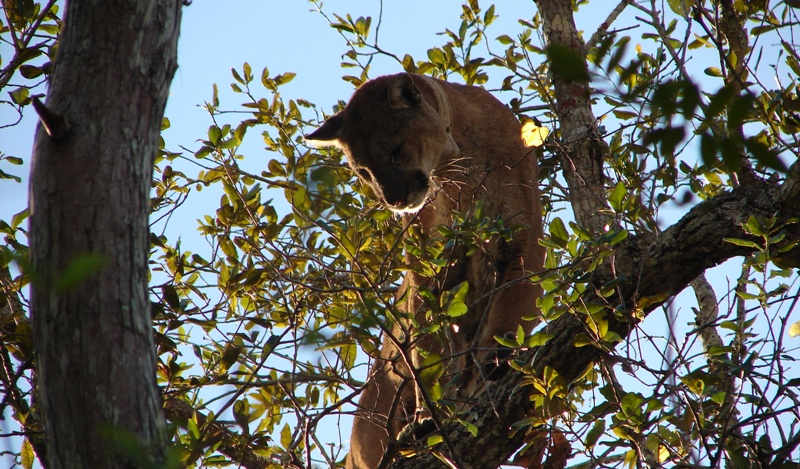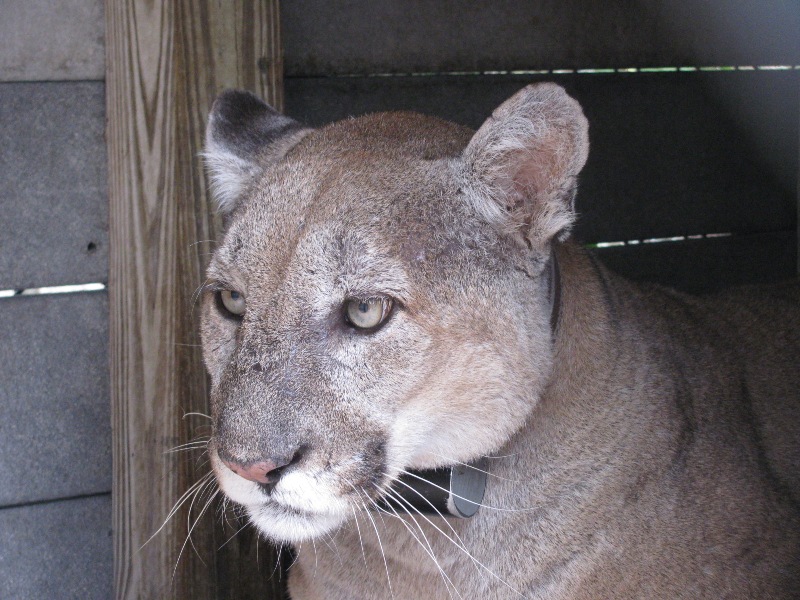Panthers Shy But Still Roaming
By Kaitlyn Carroll
The panthers in Florida are so few and far between that even the park rangers and locals often never see one. “You have to spend a lifetime here to catch a glimpse,” said Patrick Boyce, a ranger at Big Cypress National Preserve. “They are very much ghost cats.”

Photo by National Parks Service
With projected numbers of anywhere from 100 to 160 adult cats in the state, the Florida panther is considered endangered. The Puma concolor coryi was one of the first species added to the U.S. Endangered Species List in 1973.
Until the mid-1970s there was a widespread belief that the panthers had gone extinct. Even into the 90s, “Their numbers had hit a plateau. Twenty to 30 adults. That’s it,” Boyce said.
In a desperate attempt to boost cat numbers, eight Texas cougars, a genetically similar species to the Florida panther, were brought into the state to mate with resident male panthers in 1995.
Deborah Jansen, the leader of the Big Cypress National Preserve panther capture team, indicated that the measure was successful. Six of the eight cougars mated with panthers and produced litters. “They were here for two years, then were all captured and removed,” Boyce said. “It seems that the genetic ‘shot in the arm’ really improved the overall genetic health of the Florida panther.” Help from the cougars brought the panthers’ numbers up to what they are today.
The most important question at the time was whether or not this hybrid breeding would help to save the original species of Florida cats. “The thought is…if they successfully breed with the panthers, won’t that make them panthers anymore? The divide became: do we protect the panther in Florida, or do we protect the Florida panther?” Boyce said. “The idea was to protect something that historically would have been panther-like…their ranges would have overlapped in historical times.”
Even with the success of the cougar experiment, both Boyce and Big Cypress National Preserve spokesman Bob DeGross expressed doubt that the panthers would recover to healthy numbers anytime soon. “I don’t imagine that will ever happen in my lifetime,” Boyce said.
Before the cougars were brought in, inbreeding was a crippling problem for the panthers. A lack of genetic diversity was causing health problems for offspring, according to Boyce. Many kittens “were being born with holes in their hearts, weren’t living past the age of one.” There were “males with undescended testicles,” he said. “It was believed there was certain morphological traits of the Florida panther, such as a kinked tail and a cowlick, but it’s the belief now that that was due to inbreeding.”
Another current and more prominent problem for the Florida panther is a constant loss of habitat. Male panthers, especially, need large areas to roam and are very territorial. “That’s actually the number one cause of death; everyone thinks it’s car accidents. Here in Florida that’s number two. The big thing in Florida is space,” Boyce said. “Naples is one of the fastest-growing cities in the U.S. The squeeze for space in Florida will be very troubling.”
Male panthers may travel up to 20 miles a day, and need 200 square miles of habitat. “Cypress, Everglades, OK these areas are protected, but north of here and all of the areas south of Lake Okeechobee, that’s on the fast track to be developed. Florida is about to become the third most populated state in the U.S…the question is how is this land going to be best utilized to maintain the species?” Boyce said.

Photo by National Parks Service
“The long-term benefit for the panthers and a lot of wildlife in the state of Florida depends on partnerships between governmental agencies and large private landowners to try to find a way to prevent conversion of those natural areas to developed areas,” said DeGross.
There are vast open spaces in the central Everglades. However, Linda Friar, a spokeswoman for Everglades National Park said humans still make an impact. “Even though we have a lot of open areas, there’s a lot of development and roadways that interrupt that so they’re killed in a variety of ways, either by road impacts with vehicles or more rural residents who find them threatening,” said Friar. People still shoot and kill panthers on occasion, even though it is against the law and results in a heavy fine.
As of April 14, so far this year there have been 12 panthers found dead in the state of Florida. “Seven of those 12 cats were killed by vehicles, and the others were all identified as unknown,” DeGross said. “One of those was in the preserve.”
While they tend to stay out of sight in Big Cypress, they still make their presence known. “They’re using this area for sure, but really don’t want to be around people whatsoever. They’re pretty cautious,” Boyce said. In the preserve, the panthers in the park are monitored with radio collars. Each collar is “good for about two or three years and you can hear it from about two miles away. Various planes will fly over, generally about three times a week, and they’re listening because each of those collars has its own unique frequency,” he said.
Each February, the panther capture team goes out to repair and replace the radio collars on the cats in the park. “We usually catch four new panthers each year and recollar four others that have collars with batteries that are failing,” Jansen said. The “capture season” only takes place once a year, during the dry season, to ensure that sedated panthers do not accidentally walk into deep water and drown. A mix of male and female adult panthers are collared to monitor both population groups.
The Florida panther is the state mammal. Many schools and organizations use the panther as their mascot. Because of the widespread familiarity with this animal, most residents around Big Cypress and panther habitat know that these animals are at risk. Boyce, whose job as a ranger is to educate sixth graders about the environment they live in, believes that the youngest generation is well informed.
“Oftentimes I ask the students…who has seen a panther. And there’s usually one or two kids who raise their hand,” he said. “They’re familiar with the Florida panther, they know it is endangered…on the whole I’d say the vast majority of the kids, I think because they live so close to so many charismatic wildlife down here, it is something they do generally care about.”
However, there is a small part of the population in Florida who do not see the panthers as creatures worth saving. “There is a belief among some people…that someone was killed by a panther,” Boyce said. “There’s no historical evidence that anyone has ever been attacked by a panther in Florida…not only killed, but even attacked.” Because of this fear, some people are afraid that resurgence in panther numbers could pose a problem for residents.
And this feeling seems to be the standard in other parts of the country, where other panther and big cat species can be violent. “You go to other parts of the country, especially with cougars, there’s a very different feeling, which is these are destructive animals that should be wiped out,” Boyce said.
“There is a reluctance to just move panthers to other areas or their historic range because it is such a large predator,” Jansen said. “The most important aspect of panther recovery today is to give them more habitat so their numbers can increase.”
The only way for the panther to be delisted as an endangered species is for three separate populations of 240 mature individuals to sustain over 14 years, according to Boyce. “We don’t even have one population,” he said. “It’s not so much a matter of biology, it’s a matter of public opinion.”
“Protecting wildlife, it’s all about values.”

Photo by National Parks Service